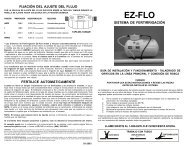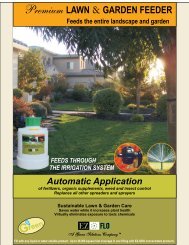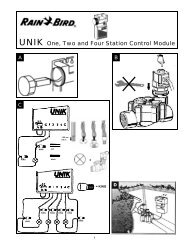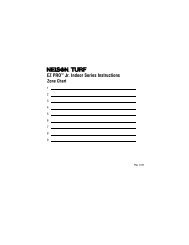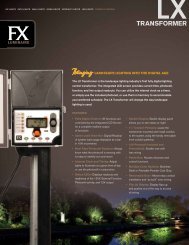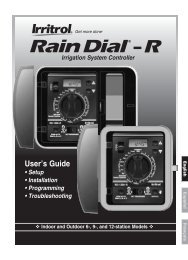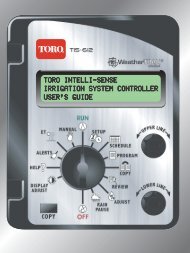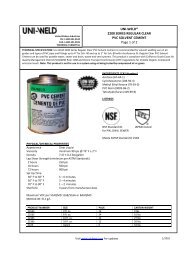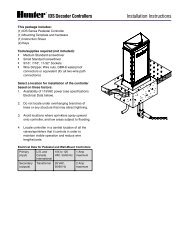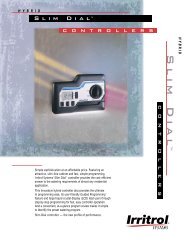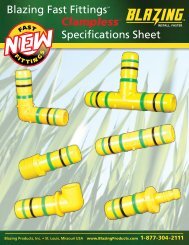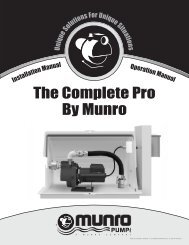Do-it-yourself! FREE Drip Irrigation Installation Guide - Garden Drip ...
Do-it-yourself! FREE Drip Irrigation Installation Guide - Garden Drip ...
Do-it-yourself! FREE Drip Irrigation Installation Guide - Garden Drip ...
Create successful ePaper yourself
Turn your PDF publications into a flip-book with our unique Google optimized e-Paper software.
Introduction<br />
A<br />
Brief History: <strong>Drip</strong> irrigation has <strong>it</strong>s roots in agriculture.<br />
In many parts of the world <strong>it</strong> is one of the few options<br />
available for the irrigation of crops and vegetables in harsh<br />
climates w<strong>it</strong>h a lim<strong>it</strong>ed water supply. Its development<br />
depended on advancements in polyethylene tubing, and <strong>it</strong>s<br />
growth was most rapid in arid and drought-plagued regions.<br />
Beginning in the late 1960's farmers discovered that by using<br />
drip irrigation they could increase yields while lowering water<br />
use. The 80's saw drip irrigation making the trans<strong>it</strong>ion into<br />
commercial landscape and home gardens w<strong>it</strong>h mixed<br />
success. In today's market, drip irrigation is well trusted and<br />
used extensively in agriculture, commercial landscapes and residential gardens. <strong>Drip</strong> irrigation's<br />
popular<strong>it</strong>y is mainly because <strong>it</strong> provides a solution to many water conservation problems.<br />
<strong>Drip</strong> irrigation is the most efficient method of irrigation today. <strong>Drip</strong> irrigation (sometimes<br />
referred to as micro irrigation, low-flow irrigation, or trickle irrigation) is the slow and precise delivery<br />
of water directly to the plant roots. <strong>Drip</strong> irrigation is controlled e<strong>it</strong>her by hand or automatic timer.<br />
Because drip irrigation is applied at the root zone, <strong>it</strong> maintains an optimum moisture level in the soil<br />
at all times resulting in less water lost to evaporation and wind. The plant roots are consistently<br />
maintained in an ideal moisture level, combining the proper balance of water and air for better<br />
growth while minimizing weed germination and growth.<br />
Microsprinklers have many of the same benef<strong>it</strong>s as a drip system, such as low flow and low<br />
operating pressure. Unlike drip irrigation, microsprinklers/sprayers, distribute water over a wide area<br />
where low volume overhead irrigation is desired. Microsprinklers are used in areas where drip<br />
irrigation would not be practical such as large areas of groundcover, flowerbeds or oddly shaped<br />
areas. Like all low volume irrigation systems, they require a pressure regulator and filter, and are<br />
available in a variety of flow rates and diameters.<br />
Advantages and Benef<strong>it</strong>s<br />
WATER EFFICIENCY: <strong>Drip</strong> irrigation applies water only when and where <strong>it</strong> is needed, w<strong>it</strong>h less runoff<br />
and evaporation from leaves and soil. <strong>Drip</strong> irrigation systems can conserve great amounts of water<br />
when compared to sprinkler systems.<br />
EASE OF INSTALLATION: <strong>Installation</strong> is a very simple process, no special tools or glue are needed.<br />
REDUCED PEST PROBLEMS AND WEED GROWTH: Watering only the roots of plants w<strong>it</strong>h drip<br />
irrigation reduces the amount of water-borne pests and fungal diseases that spread by water<br />
movement. It also inhib<strong>it</strong>s germination of weeds in the area between plants.<br />
VERSATILITY: Low volume irrigation systems are designed for placement in both new and existing<br />
landscapes. They are also ideal for installation on difficult terrain such as on slopes, in oddly shaped<br />
areas, and s<strong>it</strong>es w<strong>it</strong>h high winds.<br />
ROOT ZONE: One of the most important aspects of installing a new drip irrigation system is that a<br />
totally new and more favorable root zone environment is created, which maintains a relatively<br />
constant soil moisture level. This creates stress free plants that actively grow and resist disease.<br />
ECONOMY: Investing in a low volume irrigation system can save you money by significantly lowering<br />
your garden water use, in turn lowering your water util<strong>it</strong>y bill.<br />
LONG LIFE: All DIG products are designed to w<strong>it</strong>hstand the harshest cond<strong>it</strong>ions in both home and<br />
commercial installations. They are manufactured from high qual<strong>it</strong>y, durable plastics and contain<br />
added quant<strong>it</strong>ies of the compound Carbon Black, making them resistant to the damaging effects of<br />
ultraviolet rays.<br />
http://www.digcorp.com<br />
From product information to planning, installation and maintenance, DIG provides all you need to<br />
know about drip irrigation. Follow our easy, step-by-step instructions to design and problem<br />
solve your drip system.<br />
Getting started ………………………………………………………………………………1<br />
Planning and designing your system …………………………………………………………1<br />
About the soil …………………………………………………………………………………2<br />
Determine soil types …………………………………………………………………………2<br />
Sketch your property or area ………………………………………………………………3-4<br />
Select the methods to start a system ………………………………………………………5-6<br />
Product classifications ………………………………………………………………………6-8<br />
Determine and calculate water flow requirements ……………………………………………8-9<br />
Watering schedules: drip and microsprinklers …………………………………………………9<br />
Helpful tips……………………………………………………………………………………9<br />
Spacing charts: drippers and microsprinklers (charts A through A1) ……………………………10<br />
Product descriptions: GPH, PSI, wetting diameter, patterns (chart B) ……………………………11<br />
<strong>Drip</strong> spacing, distance and head loss (charts C thru E) …………………………………………12<br />
Maximum length and spacing for microsprinklers (chart F) ……………………………………13<br />
Review the products ……………………………………………………………………13-26<br />
AC controller ……………………………………………………………………………13<br />
Battery operated controllers ………………………………………………………………13<br />
Hose end and in-line …………………………………………………………………14<br />
Anti-siphon ……………………………………………………………………………14<br />
Starter k<strong>it</strong>s: drip microsprinklers and drip tape …………………………………………14-16<br />
4-outlet, 6-outlet PC drippers and Maverick 12-outlet retrof<strong>it</strong> drip k<strong>it</strong>s ……………………16<br />
Head assembly: components of a drip zone ……………………………………………17-18<br />
Polytube and microtube ………………………………………………………………18-19<br />
1/2" and 1/4" f<strong>it</strong>tings ……………………………………………………………………19<br />
PC, button, flags and adjustable drippers ………………………………………………19-20<br />
Earthline Brown PC dripline ……………………………………………………………20<br />
<strong>Drip</strong> soaker tape, laser drilled soaker hose and accessories…………………………………21<br />
Microsprinklers, sprayers and foggers …………………………………………………21-24<br />
Retrof<strong>it</strong> heads and accessories…………………………………………………………24-25<br />
Accessories………………………………………………………………………………25-26<br />
Parts List ………………………………………………………………………………26-30<br />
<strong>Installation</strong> Instructions …………………………………………………………………30-42<br />
Head assembly ………………………………………………………………………30-31<br />
Lateral layout …………………………………………………………………………32-33<br />
<strong>Drip</strong> em<strong>it</strong>ter ………………………………………………………………………………34<br />
<strong>Installation</strong> example drawings …………………………………………………………35-36<br />
Earth Browth PC dripline ………………………………………………………………37<br />
Microsprayers / microsprinklers and foggers……………………………………………37-39<br />
Retrof<strong>it</strong> Products………………………………………………………………………40-41<br />
In<strong>it</strong>ial system start-up ………………………………………………………………………41<br />
Problems: potential causes and solutions …………………………………………………42-43<br />
Glossary ……………………………………………………………………………………43<br />
Maintenance ………………………………………………………………………………44<br />
Questions – Call 1-800-344-2281



